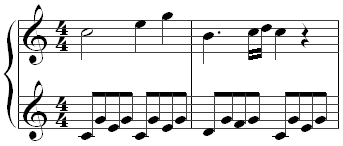Introduction to Classical Music/Theory
Music theory deals with how music works. Music theory often describes the basic elements of music. In this basic overview, we will learn the names of different notes, a few scales, different note values and dynamics.
Note Names and Notation
[edit | edit source]Musical notation means "the way music is written down". Notes are put on the lines and in the spaces between the lines.

Reading music involves being able to tell what the note is called and where to find it on the instrument, To identify music notes on a scale, first we identify which "clef" we are in. In this case, the G-clef assigns the note G to the second line.
Note Value
[edit | edit source]A note value indicates the amount of time a note is played. To determine the value of a note, we look at the color or shape of the note head, the presence or absence of a stem, and the presence or absence of flags. A rest, seen to the right of the notes below, indicates a silence of the same duration.
![]()
![]() whole note
whole note
![]()
![]() half note
half note

quarter note

 eighth note
eighth note
Taking our music sample from above, we now can see that there are 4 quarter notes for each measure of music. We can also see in the bottom of the first measure are 8 eight notes.
Dynamics
[edit | edit source]In music, dynamics refers to the softness or loudness of a sound.
The two basic dynamic symbols in music are:
- p or piano, meaning "soft" and
- f or forte, meaning "loud" or "strong".
More subtle degrees of loudness or softness are indicated by adding an "m":
- mp, or mezzo-piano, meaning "medium-quiet" and
- mf, or mezzo-forte, meaning "medium-loud" or "moderately-loud".
Beyond f and p, there are also
- ff, or fortissimo, meaning "very loud" and
- pp, or pianissimo, meaning "very quiet".

